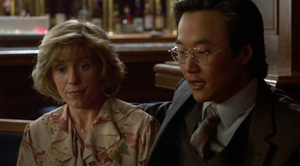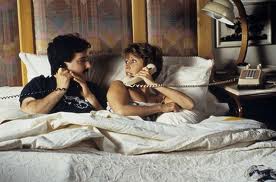
There are 4 types of subplots: one’s useless, one’s dangerous, one’s effective, and one is absolutely vital if you want the climax of your screenplay to work.
Subplots matter far more than their name implies. If a screenplay dies in Act 2 or Act 3, it’s just as likely the problem lies in the subplots as in the main narrative.
Let’s take a look at the 4 different types of subplot, and see how you can avoid the useless, be wary of the dangerous, embrace the effective, and ensure that your screenplay includes the one subplot it categorically needs.
Type 1: The useless subplot
If you’re ever sitting in a cinema and you’re bored out of your skull, there’s a good chance you’re bang in the middle of a Type 1 subplot.
The useless subplot, as its name none too subtly suggests, serves no narrative purpose. It doesn’t advance the central plot. It doesn’t develop the character. It doesn’t help explore some aspect of the theme.
It’s generally there because the writer got to about page 35, looked at the vast empty spaces of Act 2 lying ahead of them, and thought, crikey, how the hell am I going to fill all those pages? I know! Subplot!!!
The Coen Brothers are great film-makers and Fargo is one of their finest but I’m going to be so bold as to suggest this Oscar winner includes a dreaded Type 1 subplot. If anyone can tell me what purpose is served by Marge’s dinner with her slightly crazy high school buddy, Mike, I’d love to hear it. (And fortunately someone has – see below in the Comments. Thanks Kathleen and Joshua.)
Given their fecundity, it’s unlikely the Coens were looking to rack up a couple of easy pages here. But nor is it clear what bit of movie magic happens in the scene that made it impossible for them to leave this subplot out. It’s a mystery to me.
This might seem self-evident, but the first tip I have regarding subplots is this: make sure they serve some narrative purpose.
Type 2: The dangerous subplot
The second type of subplot is the thematic subplot. This is where you explore, possibly with minor characters, some other dimension of your premise – what it is you’re trying to say. One of my favourite romantic comedies, Moonstruck, has a couple of thematic subplots.
The main narrative is about whether Loretta (Cher) will marry her pathetic fiancé Johnny Cammareri (Danny Aiello) or ditch him for his more passionate brother Ronny (Nic Cage) – who, to complicate matters, she sleeps with while delivering the wedding invite. But there are two other subplots.
Her father, Cosmo (Vincent Gardenia) is having an affair with the aptly named Mona, and her mother, Rose (Olympia Dukakis) is getting hit on by a lecherous lecturer (John Mahoney).
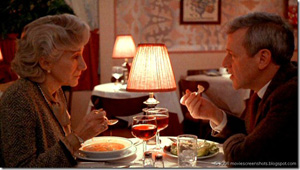
The subplot with Rose (Olympia Dukakis) and the jaded lecturer (John Mahoney) explores theme but doesn’t have any impact on the throughline of the film.
While it’s true that Loretta and Ronny do run into Cosmo and Mona at the opera, I wouldn’t say that the main narrative is affected in any material way by either of these two subplots. They are just there to explore other dimensions of love, lust and relationships.
Do they work in Moonstruck? Yes, they do. So why do I call thematic subplots “dangerous”? Because not all of us are as talented John Patrick Shanley. He won the Oscar for this screenplay Oscar and was nominated again for Doubt. This guy is seriously good so he, like Aaron Sorkin, can get away with stuff that mere mortals can’t.
But, in the absence of prodigious skill, the type 2 thematic subplot can easily slip a classification and become an utterly useless Type 1 subplot.
For the developing writer, I would urge caution in relation to thematic subplots and encourage you, at least initially, to focus on trying to include more of the next two types of subplot.
Type 3: The effective subplot
Obviously we’d like to our subplots to be effective but how do we achieve that? The secret to successful subplots is to have them ultimately come back and have an impact on the main narrative.
However insignificant it might seem upon introduction, a good subplot should eventually escalate the drama by making it harder for your protagonist to achieve their goal. A subplot is effective and justifies its place in the script if it ultimately causes a serious complication for the hero.
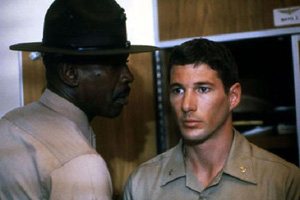
The subplot about Zac’s blackmarket dealings triggers the transformation of the protagonist in An Officer and a Gentleman
Let’s take a look at An Officer and a Gentleman.
The central narrative is about Zac Mayo (Richard Gere), a smartarse from the wrong side of the tracks, trying to graduate from the navy’s aviator school. That’s the throughline.
But Zac has a little blackmarket business going in shiny shoes and belt buckles to help guys make sure they get their weekend “liberty” leave. This subplot is very important. Why? Because it ultimately comes back and affects that throughline.
Drill Sergeant Foley (Lou Gossett Jr) – Zac’s mentor and antagonist – discovers this illicit sideline and wants him to quit from the program. “I want your D.O.R. (Discharge On Request)”.
This triggers the supreme ordeal that is so important to the transformation of the protagonist (see my post on The Midpoint).
It’s a simple subplot that’s introduced without fanfare but it ultimately creates a complication that threatens the hero’s pursuit of his goal and triggers evolution of the character. That’s an effective subplot, wouldn’t you say? It works because it complicates and escalates the drama.
In Dead Poets Society, the throughline is about the boys embracing a more romantic view of life under the inspiration of their charismatic English teacher, Mr Keating (Robin Williams). But there is also a subplot about the relationship between Neil (Robert Sean Leonard) and his father that has a monumental impact on the throughline.
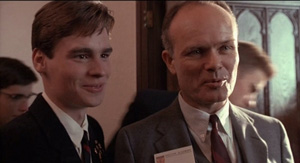
The relationship btw Neil Perry (Robert Sean Leonard) and his repressive father is the subplot that triggers the Act 2 Turning Point in Dead Poets Society
Knowing his repressive father won’t allow him to play Puck in A Midsummer Night’s Dream, Neil forges his signature on a consent form. This happens early in Act 2 and Neil has a great old laugh as he mimics his father at the typewriter so we don’t think a whole lot of it. But a seed has been sown.
When his father discovers the deception, he yanks Neil out of the school, and threatens him with military school, which triggers Neil’s suicide, which in turn provides the unlikely hero, Todd (Ethan Hawke) with the opportunity to literally take a stand at the climax.
If this subplot weren’t there, Neil lives and Todd might forever continue to live life in the shadows. This climax not only affects the throughline, it facilitates its stunning conclusion. By any measure, I’d say that’s an effective subplot.
In When Harry Met Sally, there is a subplot involving their best friends, Jess (Bruno Kirby) and Marie (Carrie Fisher). On the surface, this might look like it’s just a thematic subplot, the rapidity of their movement from meeting to marriage contrasting sharply with the slow burn of the relationship between the eponymous central characters. But it does more than that.
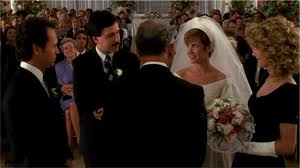
The subplot involving best friends Jess (Bruno Kirby) and Marie (Carrie Fisher) provides the trigger for the Act 2 Turning Point in When Harry Met Sally.
The wedding of Jess and Marie forces Harry and Sally, whose friendship has been severed after they finally slept together, to come together under the one roof again. This triggers a fractious exchange in the restaurant kitchen where Sally slugs Harry, triggering the Act 2 Turning Point. No Jess and Marie and the writer, Nora Ephron, would have to have contrived some other way for this crisis to be precipitated. Because of this subplot it happens absolutely organically. That makes it a really good subplot.
However, there is a further class of subplot that matters even more than this. This is the one subplot you absolutely need if you want your screenplay to sing.
To find out about this vital subplot, you’re going to have to read my next post – the one subplot you really need.
Join the Cracking Yarns mailing list
Learn about our Screenwriting Courses
Learn about our Online Screenwriting Courses
Learn about our Free Screenwriting Webinars
Learn about our Script Assessment options
Subscribe to the Cracking Yarns YouTube channel
